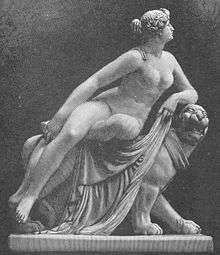Johann Heinrich von Dannecker

Johann Heinrich von Dannecker (October 16, 1758 in Stuttgart – December 8, 1841 in Stuttgart) was a German sculptor.
He was the third of five children of Georg Dannecker (1718–1786), a coachman of the nobleman Charles Alexander, Duke of Württemberg. In 1764, the family moved to Ludwigsburg (Baden-Württemberg). He was entered in the military school at the age of thirteen,[1] but from 1772 to 1780 he was educated as a sculptor, together with Philipp Jakob Scheffauer (1756–1808). Initially, he studied under Adam Bauer, and, starting in 1775, at the military academy at Stuttgart. In his eighteenth year he carried off the prize at the Concours with his model of Milo of Crotona. On this the duke made him sculptor to the palace (1780), and for some time he was employed on child-angels and caryatids for the decoration of the reception rooms.[1]
After finishing the academy in 1780, he traveled to Paris, Rome, Bologna and Mantua and returned to Stuttgart in 1790, where he worked as a professor at the Hohe Karlsschule until 1794.
Apart from some short trips he never left Stuttgart again. His works now showed the double influence of his admiration for Antonio Canova and his study of the antique. The first was a girl lamenting her dead bird, which pretty light motive was much admired. Afterwards, Sappho, in marble for the Lustschloss, and two offering-bearers for the Jagdschloss; Hector, not in marble; the complaint of Ceres, from Schiller's poem; a statue of Christ; Psyche; kneeling water-nymph; Love, a favourite he had to repeat.[1] In 1804, he did the initial draft of "Ariadne on the Panther", which he finished from 1810 to 1824, generally regarded as his masterpiece and one of the most important sculptures of the 19th century.
After the death of his schooltime friend Friedrich Schiller, Dannecker created a bust of him, which was copied by his sculptor friend Reinhold Begas for the monumental Schiller statue erected on Berlin's Gendarmenmarkt. In 1823 and 1824 he created a bust of John the Baptist.
References
- 1 2 3
 One or more of the preceding sentences incorporates text from a publication now in the public domain: Chisholm, Hugh, ed. (1911). "Dannecker, Johann Heinrick Von". Encyclopædia Britannica. 7 (11th ed.). Cambridge University Press. p. 810.
One or more of the preceding sentences incorporates text from a publication now in the public domain: Chisholm, Hugh, ed. (1911). "Dannecker, Johann Heinrick Von". Encyclopædia Britannica. 7 (11th ed.). Cambridge University Press. p. 810.
- Adolf Spemann: Dannecker Berlin/Stuttgart 1909
- Ellen Kemp: Ariadne auf dem Panther Ausst.Kat. Liebieghaus. Museum alter Plastik. Frankfurt/Main 1979
- Christian von Holst: Johann Heinrich Dannecker. Der Bildhauer Stuttgart 1987 (mit Werkverzeichnis)
- Ulrike Gauss: Johann Heinrich Dannecker. Der Zeichner Stuttgart 1987
- Christian von Holst (Hrsg.): Schwäbischer Klassizismus zwischen Ideal und Wirklichkeit 1760–1830 Ausst.Kat. Staatsgalerie Stuttgart. Stuttgart 1993
- Nagel, Yvan: Johann Heinrich Dannecker: Ariadne auf dem Panther. Zur Lage der Frau um 1800. Frankfurt am Main 1993
- Blisniewski, Thomas: „Zur Wollust einladend“ – Johann Heinrich Danneckers Ariadne auf dem Panther. In: ARTig. Die Zeitschrift für Kunstinteressierte. 5.2004, S. 9-20
| Wikimedia Commons has media related to Johann Heinrich Dannecker. |